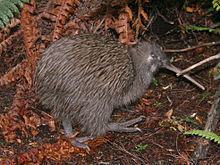Southern brown kiwi
The southern brown kiwi or tokoeka[3] (Apteryx australis) is a bird in the family Apterygidae. It lives in New Zealand. This bird does not fly. It runs on the ground.[4][2]
| Southern brown kiwi | |
|---|---|

| |
| Scientific classification | |
| Domain: | Eukaryota |
| Kingdom: | Animalia |
| Phylum: | Chordata |
| Class: | Aves |
| Infraclass: | Palaeognathae |
| Order: | Apterygiformes |
| Family: | Apterygidae |
| Genus: | Apteryx |
| Species: | A. australis
|
| Binomial name | |
| Apteryx australis (Shaw, 1813)[2]
| |

| |
Appearance change
The southern brown kiwi is about 45 cm long. The adult male kiwi weighs about 2.4 kilograms and the adult female weighs about 3.1 kilograms. The birds living on Stewart Island are the largest. It has red-brown feathers and no tail.[2] It has a long, curved beak. The nostrils are at the end of the beak and not up at the top near the rest of its face.
Habitat and food change
The southern brown kiwi lives in forests, scrublands, grasslands and up in hills below the Alpine zone.
Before human beings came to New Zealand, tokoeka lived in many parts of the southern and eastern part of the South Island as far north as North Canterbury.[2]
Most southern brown kiwis hide during the day in burrows, areas with plants or hollow trees and look for food at night, but others look for food during the day. They walk along the ground and tap their beaks against it. They eat animals without bones, for example earthworms, insect larvae, centipedes, spiders and weta. Kiwis fight each other over good places to find food.[2]
The kiwi's closest relative is the elephant bird. It lived in Madagascar long ago. Its closest living relatives are the emu and cassowary.[5]
Eggs change
Both male and female southern brown kiwi sit on the eggs in the nest. Sometimes other adult kiwi will help too.[6]
Threats change
Before human beings came to live in New Zealand, the southern brown kiwi lived all through the south and east of New Zealand's South Island. There are fewer southern brown kiwi today because human beings change the places where they live and because dogs, cats, stoats and other introduced species eat them. To save the southern brown kiwi, some humans take their eggs and chicks and raise them on islands where there are no stoats.[2]
Subspecies change
There are two or three subspecies of southern brown kiwi: Everyone agrees that the Fiordland tokoeka (A. a. australis) and the Stewart Island tokoeka (A. a. lawryi) are subspecies. Scientists do not think that the Haast tokoeka (A. a. Haast) is a real subspecies, but the people trying to keep the birds alive decided it was easier to save the birds if they acted as if it were a third subspecies.[2]
History change
For years, historians disagreed about where Western scientists found the first kiwi specimen, meaning the first dead kiwi that they brought back to universities for study. The first speciimen is usually the one scientists use as a holotype. The holotype is the individual plant or animal that scientists use for the first formal scientific writeup of a species.
George Shaw from the British Museum wrote the first paper about the kiwi in 1813 in his group of books Vivarium naturae. A friend had brought him the kiwi skin. The friend got it from a ship captain named Andrew Barclay. He was captain of a fighting ship and prisoner transport ship called the Providence. It wasn't clear exactly where the ship captain got it.
In 2019, scientists took a tiny piece of the kiwi skin and did DNA analysis. They found the dead kiwi was most closely related to kiwis from Rakiura, an island south of New Zealand's South Island.[7]
References change
- ↑ BirdLife International. "Southern Brown Kiwi: Apteryx australis". IUCN Red List of Threatened Species. 2019. The IUCN Red List of Threatened Species: e.T22678122A155418586. doi:10.2305/IUCN.UK.2019-3.RLTS.T22678122A155418586.en. Retrieved August 18, 2021.
- ↑ 2.0 2.1 2.2 2.3 2.4 2.5 2.6 "Southern Brown Kiwi". New Zealand Birds Online. Retrieved August 18, 2021.
- ↑ Anna Folch; Francesc Jutglar; Ernest Garcia (2020). "Southern Brown Kiwi (Apteryx australis)". In Del Hoyo, Josep; Elliott, Andrew; Sargatal, Jordi; Christie, David; De Juana, Eduardo (eds.). Southern Brown Kiwi: Apteryx australis. Cornell University lab of Ornithology. doi:10.2173/bow.sobkiw1.01. S2CID 240992017. Retrieved August 20, 2021.
- ↑ BirdLife International (2016). "Southern Brown Kiwi: Apteryx australis". 2019. The IUCN Red List of Threatened Species: e.T22678122A155418586. doi:10.2305/IUCN.UK.2019-3.RLTS.T22678122A155418586.en. Retrieved August 18, 2021.
{{cite journal}}: Cite journal requires|journal=(help) - ↑ Laura Erickson. "Southern Brown Kiwi". Laura Erickson's For the Birds. Retrieved August 20, 2021.
- ↑ Rogan Colbourne (2002). "Incubation behaviour and egg physiology of kiwi (Apteryx spp.) in natural habitats". New Zealand Journal of Ecology. 26 (2). New Zealand Ecological Society: 129–138. JSTOR 24055315. Retrieved August 21, 2021.
- ↑ Paul Scofield; Vanesa De Pietri (April 13, 2021). "Forensics and ship logs solve a 200-year mystery about where the first kiwi specimen was collected". The Conversation. Retrieved August 19, 2021.
